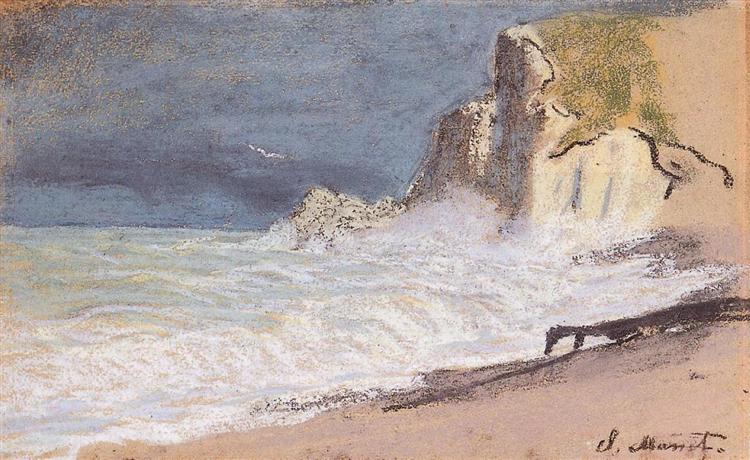Description
The work "El Manneport - Etretat - Amont Cliff - bad weather" by Claude Monet, painted in 1886, is a glowing manifestation of the artist's impressionist genius and a testimony of his deep connection with the climatic variations and the transformations of light in the nature. Located on the Normandy coast, this painting evokes a moment of intrigue and beauty, where the forces of nature seem to be in a dramatic game on the canvas.
Visually, the work is dominated by a horizon in which the sky and the sea are intertwined, creating a loaded and dynamic atmosphere. The gray and blue tones of the sky, dotted with turbulent clouds, contrast with the ocher and brown of the coast. This use of color not only establishes the emotional tone of the work, but also reflects Monet's mastery in the capture of light and its effect on landscape elements. Monet's palette tends towards a range of colors off, suggesting the intensity of bad weather and presenting a landscape that is torn between serenity and tumult.
The composition is carefully balanced. The immense rocks of Acent, with their rough texture, emerge with force from the seabed, while the waves break against them, creating a sense of movement that reinforces the idea of nature in action. Monet uses loose and energetic brushstrokes to give life to this scenario, resulting in an almost tangible atmosphere that invites the viewer to experience the marine breeze and the strength of waves.
Although the work does not present human characters, his feeling is deeply evocative; The viewer can almost imagine the presence of fishermen or passersby who have been displaced by the sudden arrival of bad weather. This absence of human figures does not reduce value to work. On the contrary, it allows the landscape to speak by itself, highlighting the majesty and the ferocity of nature in its purest state.
The historical context in which Monet executes this piece is significant. At the end of the 19th century, impressionism had begun to consolidate as a fundamental artistic movement in the search for a more personal and subjective expression of the world. Monet, like other impressionists, feels captivated by the need to transmit direct visual experience rather than the detailed representation of reality. This work is a clear reflection of that philosophy, where the capture of light and the weather becomes the protagonists of the painting.
Monet was known for its series of landscapes that explored the same location at different times of the day and in different climatic conditions. "Manneport - Etretat - Ambant Cliff - Bad weather" can be understood as part of that same exploration. Through its inability to stagnate in a style or form, Monet reinterprets the notion of landscape and object, turning the environment into a constant study subject.
When observing "the Manneport", one cannot avoid feeling the connection with the impressionist movement that Monet helped define. In this work, he captures not only a moment in time, but also a visceral emotion that causes a reflection on the nature itself and the role of the human being in its majesty and its vulnerability. Thus, "Manneport - Etretat - Ambant Cliff - bad weather" is erected as a visual meditation on the relationship between the human being and its environment, an echo of duality that permeates all Monet's works.
KUADROS ©, a famous paint on your wall.
Hand-made oil painting reproductions, with the quality of professional artists and the distinctive seal of KUADROS ©.
Reproduction service paintings With a guarantee of satisfaction. If you are not completely satisfied with the replica of your painting, we refund your money 100%.

